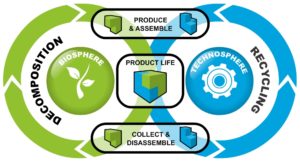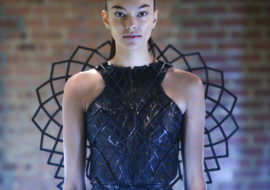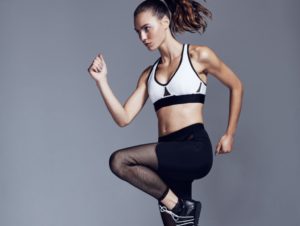Young plant growth in lady shoe, recycle concept
Fashion Industry as a circular business model

“I think the biggest innovations of the 21st century will be at the intersection of biology and technology. A new era is beginning.”
Steve Jobs
The fashion industry is known to be irreverent, defiant, in one word, a trendsetter.
Let’s remember that before fashion, clothing is a basic need. As humans, we need it as a “shelter” from the environment, as a cover, according to the Maslow’s hierarchy of needs. Only after having satisfied this, clothing moves towards fashion.
Seen from an economic point of view, the production of clothing items has changed immensely throughout history. The emergence of the mass consumption and production during the 20th century was a limestone in the industry. Prêt-à-porter or ready-to-wear clothes promoted standardisation and made garments more accessible, being sold in many shops at more modest prices. However, this standardisation had secondary effects, such as making clothes so cheap that people would dispose of them more rapidly too.
Sustainability
Towards the end of the 20th century a new trend of sustainability has emerged. Problems such as global warming and overuse of raw materials, have taken their toll on our planet. Therefore, there have been increasing attempts to take care of nature by implementing sustainable forms of living, such as recycling, renewable energies, non-fossil fuels, and of course, mode.
The above mentioned traditional cycle of procurement, manufacture, use and disposal has evolved to a more complex one in the recent decades, with influences from the “cradle to cradle” model and ecodesign and biomimicry trends that attempt to recycle goods for a more sustainable production and better use of natural resources. These trends aim to promote the recycling of products which will avoid the production of waste by reusing and/or recycling goods, textiles, furniture, etc. being the options in this case are very broad.

With a business perspective in mind, this can be translated as a circular economy model – a new kind of business model innovation: it is based in two types of material flows; the first one involves prolonging the life of a high quality and recyclable product that will not end up in waste but after living several cycles; the second one is a product designed to re-enter the biosphere in a safe way without negatively affecting it (Source here).
The dissemination and applicability of this knowledge can basically reach any industry, but in this case, the focus of the post is the fashion industry. It becomes very interesting then to think about how to land this set of ideas, how designers and Houses of Mode are coping with the use of technology and with the needs of their clients while trying to be sustainable.
FASHION WEEK -what’s on?
To what extent has the fashion industry involved/used these innovations to create sustainable garments? At what point can fashion implement technology and create high-tech garments that seem like out of a futurist/ sci-fi film?
When we get to this point the opportunities are infinite, as in the framework of the Fashion Week collection spring/summer 2016 showing examples of garments designed using biomimicry intertwined with technology, such as Becca McCharen’s biometic-controlled dress that making use of an integrated Intel computer and sensors detect adrenaline levels by measuring body temperature, respiration and perspiration, therefore adapting to the body’s needs.

Becca McCharen’s Adrenaline Dress, Picture source here
Another example from the same designer is the Smart sports bra, that open its integrated vents in order allow perspiration when needed.
Fashion trends are endless, in the next post I will approach sustainable and tech- related options to clothing, such as biomimicry, 3D printing, vintage, second-hand, renting, etc. and I will try to land those with examples of designers and manufacturers to be used as inspiration and eye opener for what is coming
.

Becca McCharen’s sport bra

